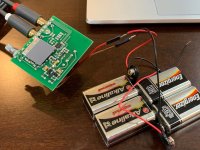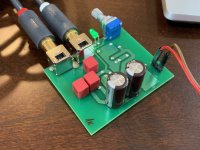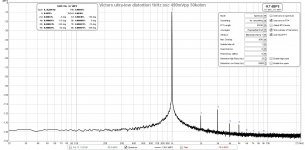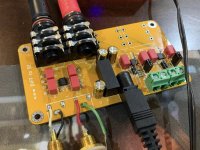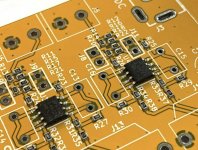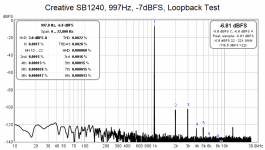Impressive numbers! Could you pls describe your test setup?Tpa6120a2 composite amplifier
8ohm 2Vrms 500mw and noise floor.
Impressive numbers! Could you pls describe your test setup?
Pre distortion calibrated(using add harmonic function in rew) without the amplifier in the signal chain. Then measure the distortion with the amplifier with and without load.
Dac: topping dx3pro
Adc: motu 828es
load: 8ohm 20W resistor
Single ended all the way through
To validate the method, I measured Jds atom, jds o2, dx3pro and with various modifications, as well as iterations of my own designs with 8ohm 32ohm load. I can say the incremental improvements from each step is clearly differentiated in this setup. If measured on APx555, I believe the measurements will be even better.
I just found out how to measure distortion on a Class D bridge tied load (BTL) amp where both wires are antiphase and live. You need to use a symmetric divider, say 9k1-2k-9k1 across the dummy load and put the Focusrite balanced XLR input across the middle 2k but bypassed with a film cap on each wire.
More here:
TPA3255 Reference Design Class D Amp GB
Setup:
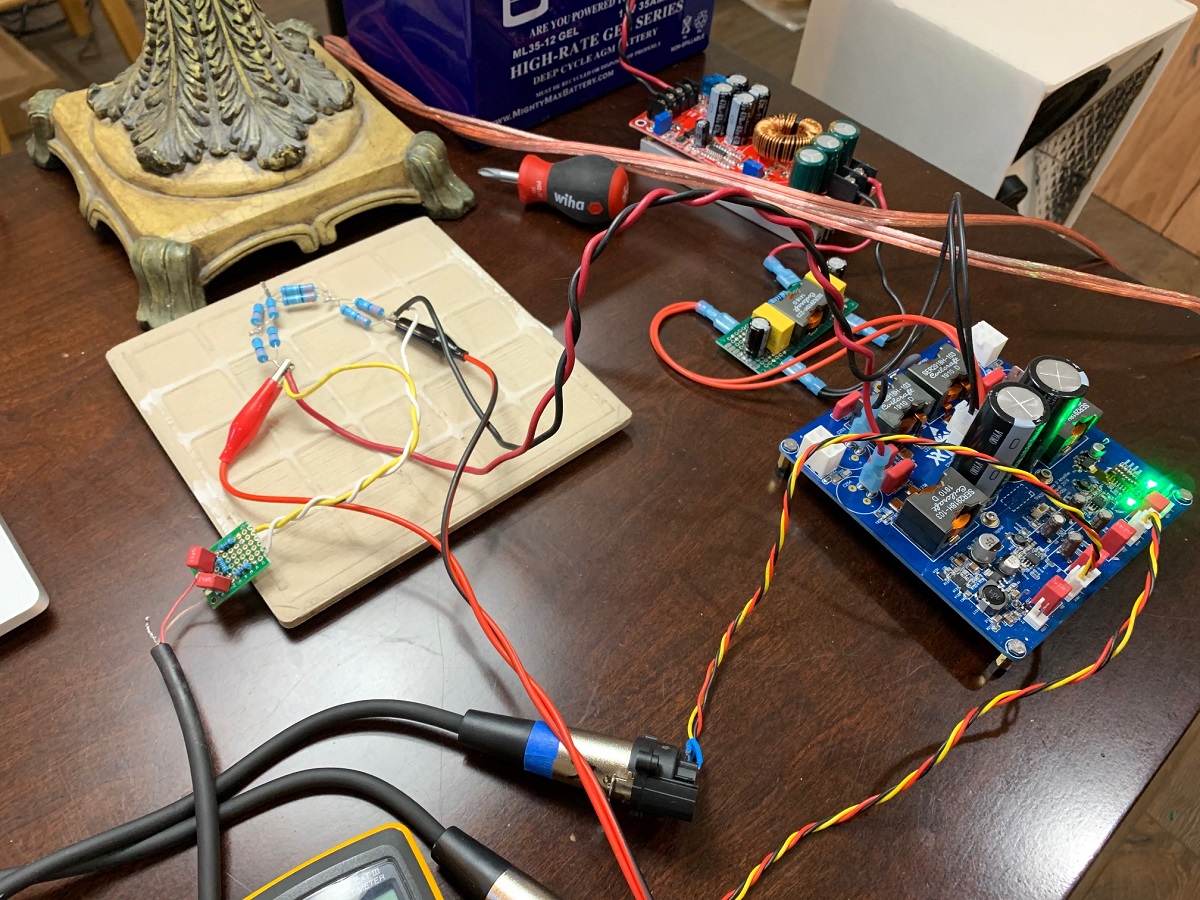
Here’s the divider:
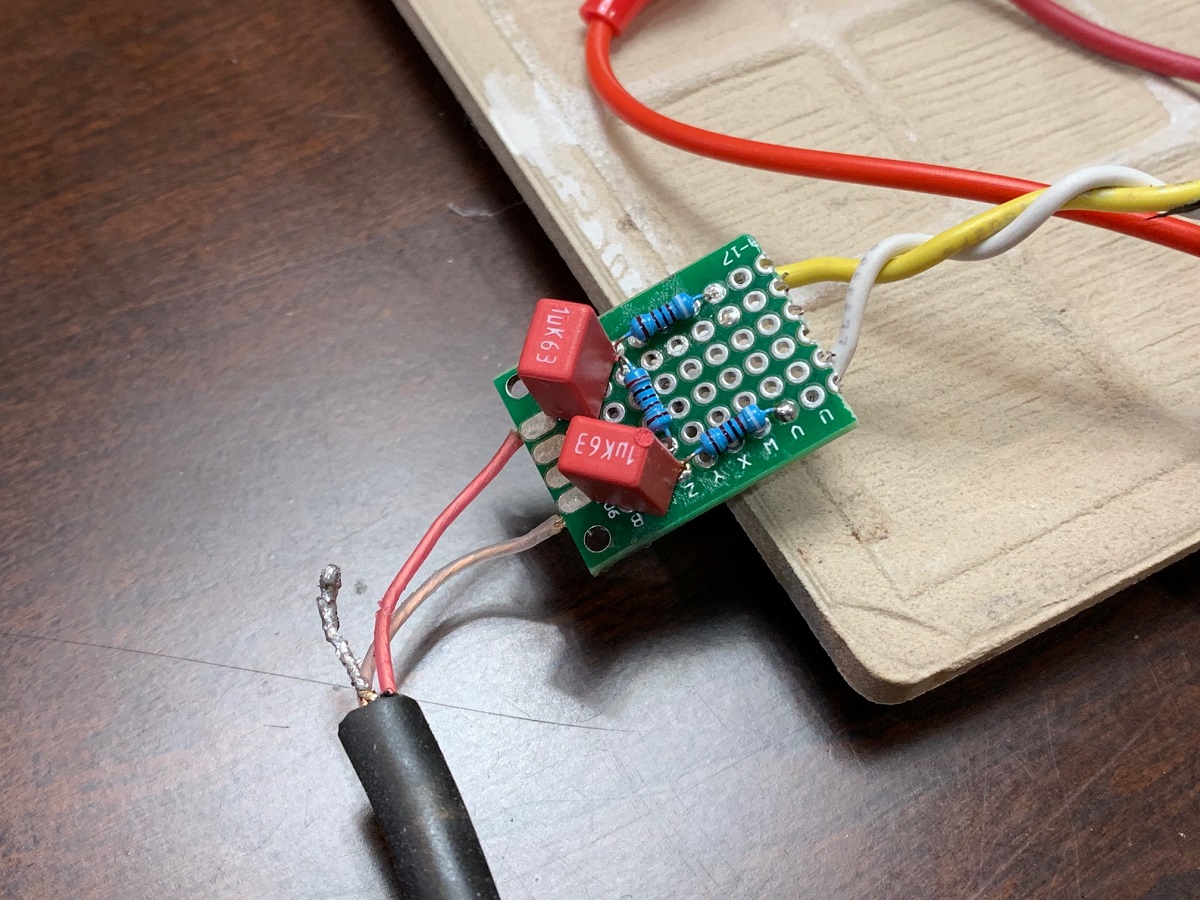
It’s an abbreviated one (only 20dB) used by Voltwide here:
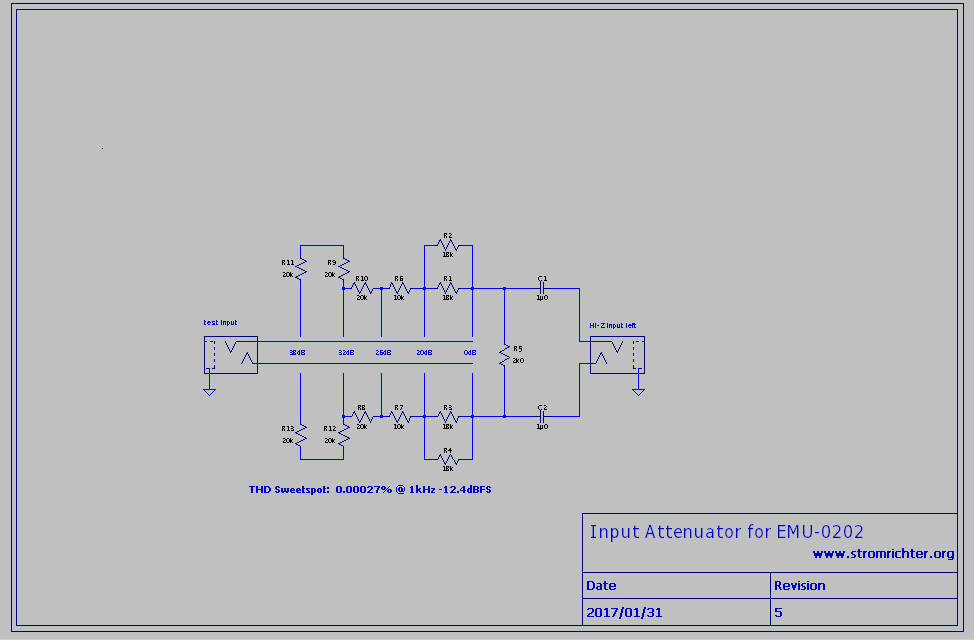
I used an asymmetric divider previously with DC coupled balanced inputs and it got very high (artificial) H2.
Here is the data from asymmetric divider:
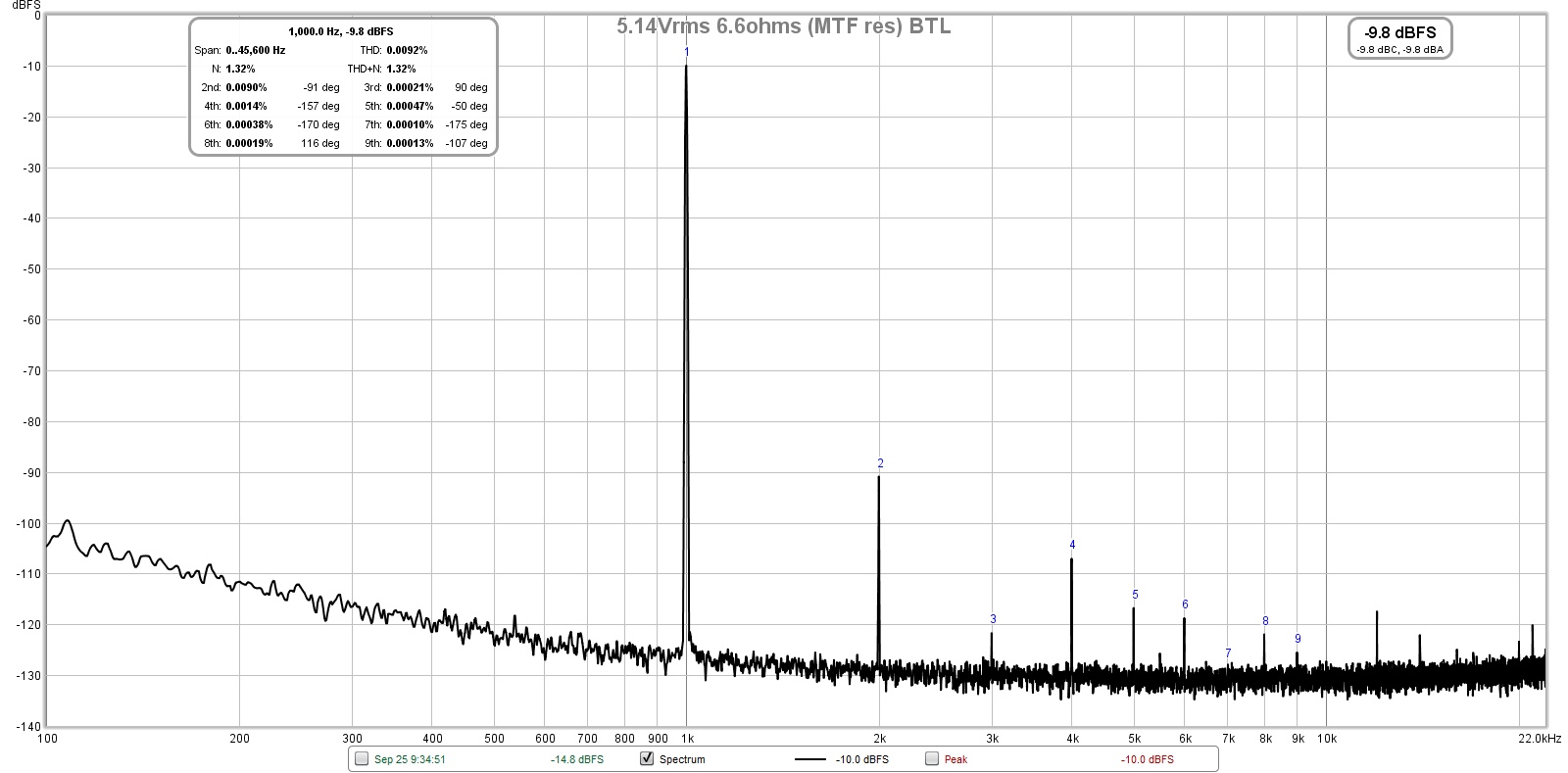
To symmetrical divider:
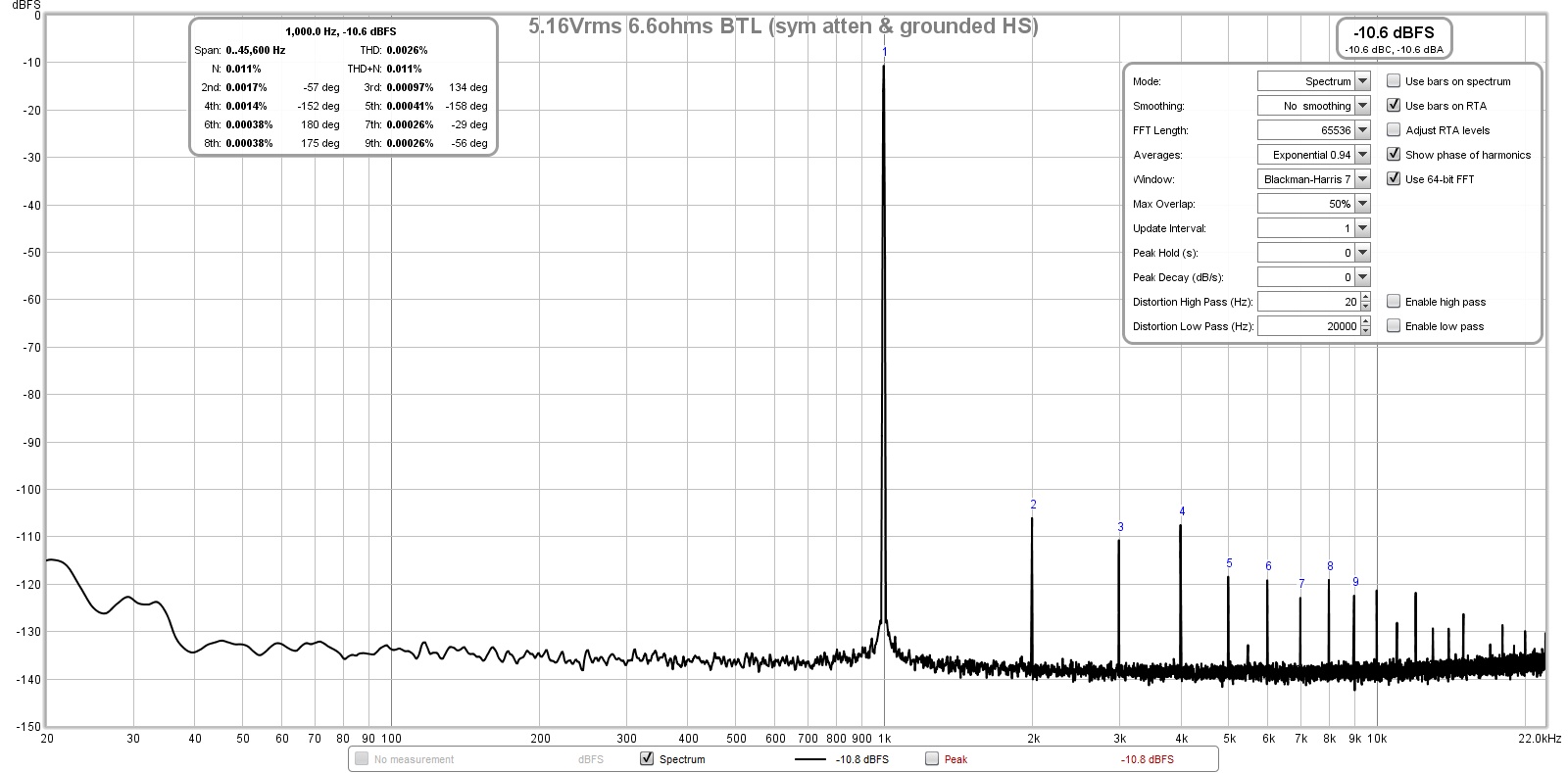
More here:
TPA3255 Reference Design Class D Amp GB
Setup:
Here’s the divider:
It’s an abbreviated one (only 20dB) used by Voltwide here:
I used an asymmetric divider previously with DC coupled balanced inputs and it got very high (artificial) H2.
Here is the data from asymmetric divider:
To symmetrical divider:
Last edited:
I guess this is the kind of approach one would use for any BTL amp? A Modulus-686 is in the pipeline, and I fully intend to measure HD and noise.
nothing wrong with this test for any BTL amp. TI is the only brand I can comment on, and these chips produce some common mode output distortion that is cancelled when driven in BTL mode.
I received one of Victor's ultra low distortion 1 kHz oscillators - it should have levels immeasurable to the Focusrite, so what we will see will basically be the limit of the Focsurite. I used 4x 9v batteries to give it a clean source of 35v. At the lowest output setting of 490mVpp and fed into to internal 50kohm input impedance of the Focusrite 2i4, I am getting the following:
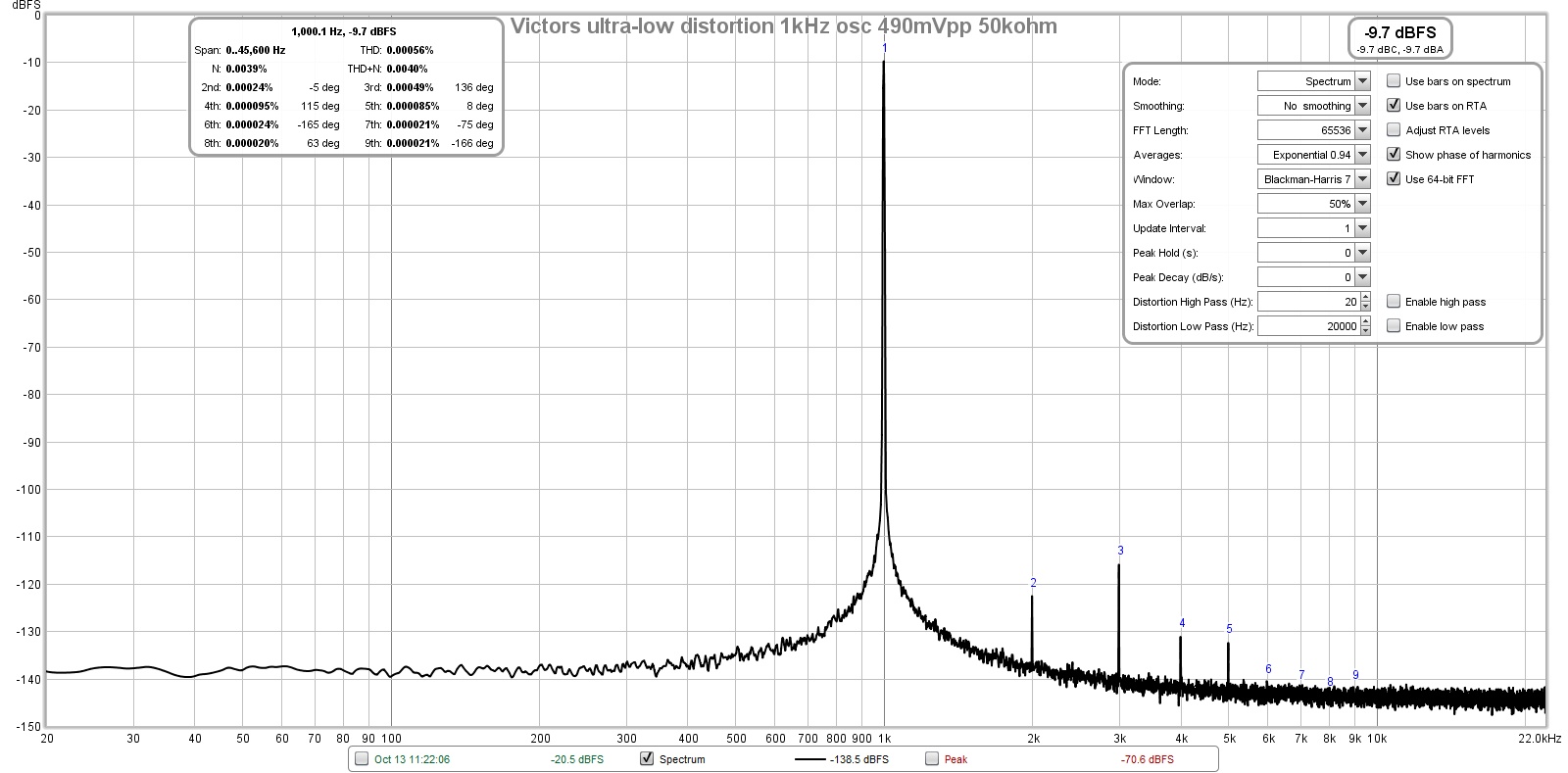
The noise floor is amazing - I have never measured anything this quiet, and it is not even inside a case yet.
There is a 3rd order peak that is rather high and stays constat during the time averaging process, so probably part of the Focusrite fron end.
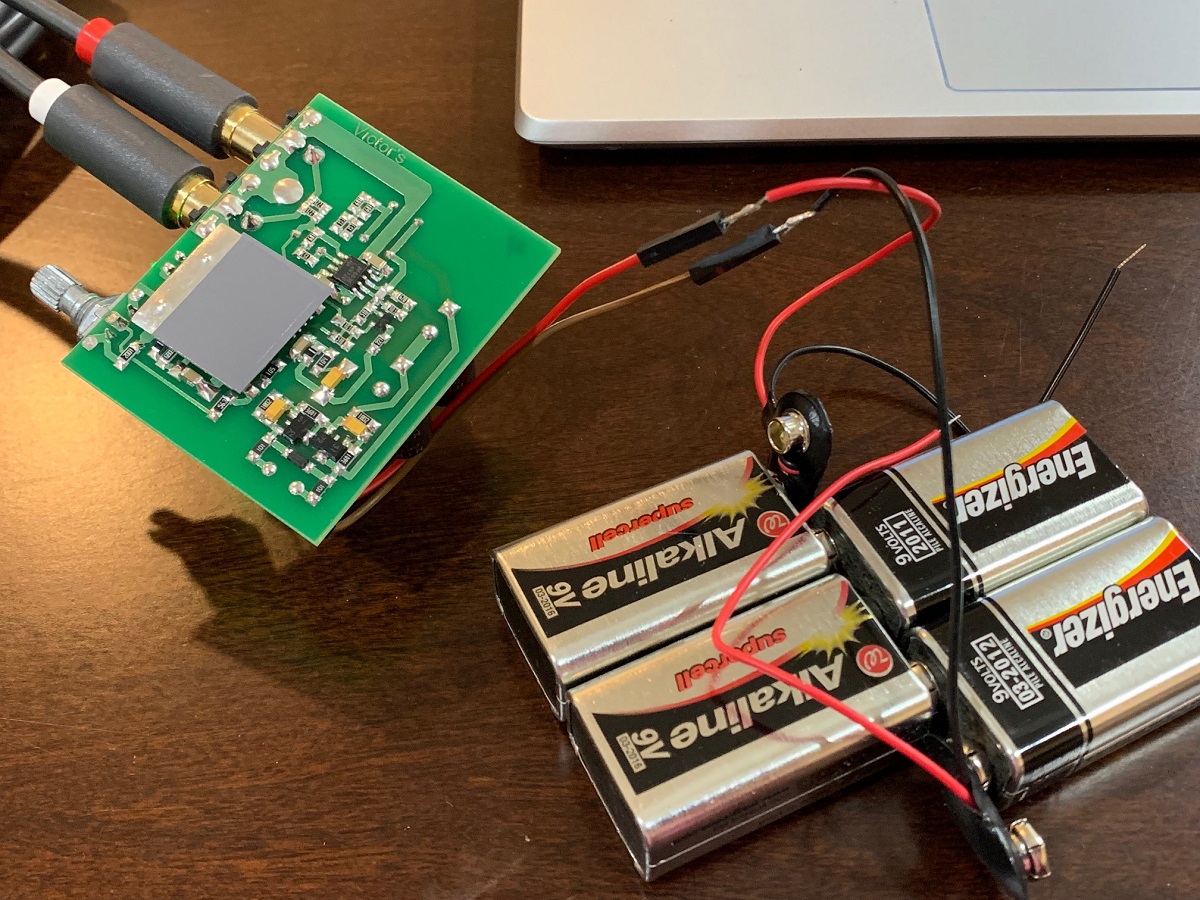
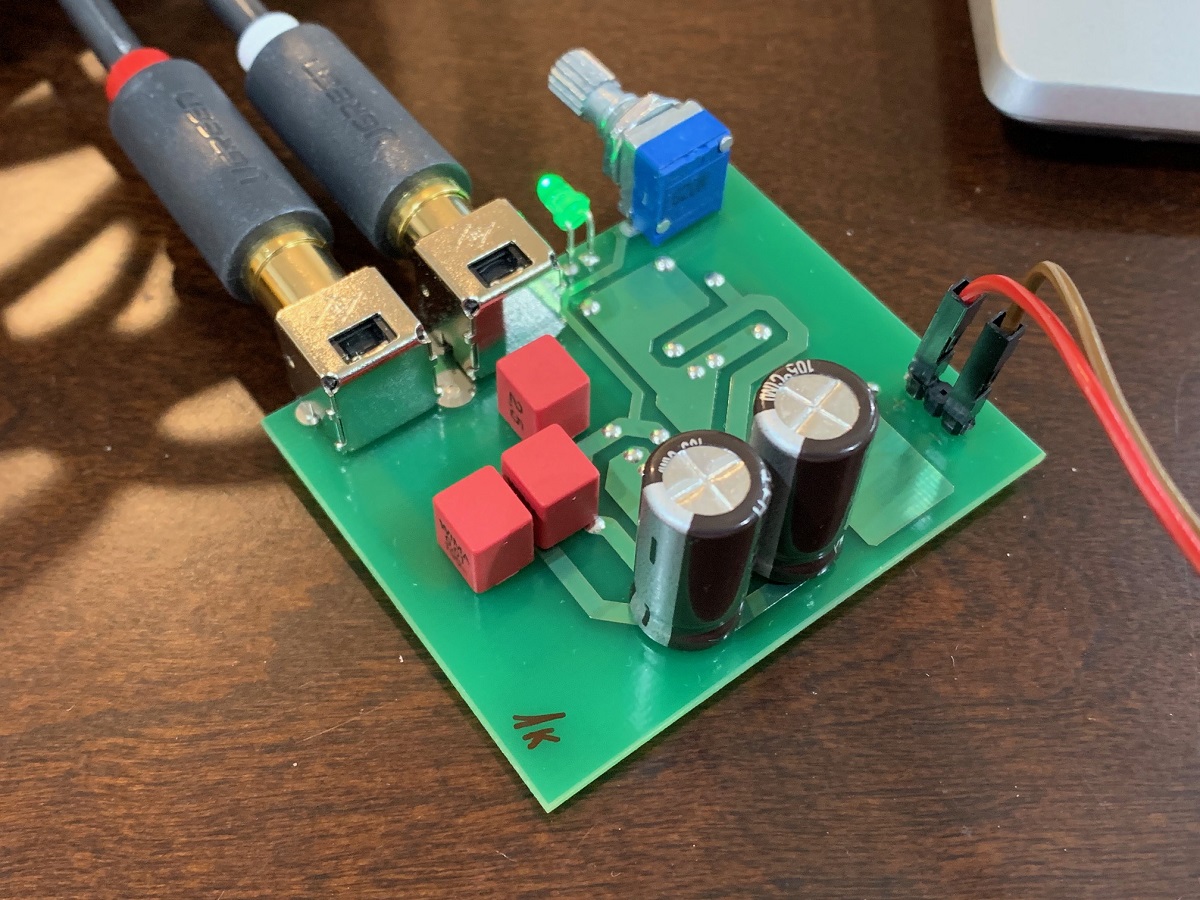
Very nice unit prebuilt for 50 Euro. Highly recommended.
The noise floor is amazing - I have never measured anything this quiet, and it is not even inside a case yet.
There is a 3rd order peak that is rather high and stays constat during the time averaging process, so probably part of the Focusrite fron end.
Very nice unit prebuilt for 50 Euro. Highly recommended.
Attachments
In case anyone is interested in Victor's ultra-low distortion oscillator, just send him a PM @vicnic.
https://www.diyaudio.com/forums/members/vicnic.html
https://www.diyaudio.com/forums/members/vicnic.html
I am getting oscillators and notch filters from him. I'm super excited.In case anyone is interested in Victor's ultra-low distortion oscillator, just send him a PM @vicnic.
The Focusrite Scarlett 2i2 was recently tested. The 2i2 unit is a good unit especially if you use the low distortion oscillators (Akitika and Victor’s) mentioned in this thread.
Here are the 2i2 measurements:
Focusrite Scarlett 2i2 Audio Interface Gen 3 Review | Audio Science Review (ASR) Forum
I think it did quite well overall.
Best,
Anand.
Here are the 2i2 measurements:
Focusrite Scarlett 2i2 Audio Interface Gen 3 Review | Audio Science Review (ASR) Forum
I think it did quite well overall.
Best,
Anand.
New to this thread.
Thanks xrk971 for starting this - don't know how I missed it.
Thanks to all the contributors.
Will try to get a Mac system up soon using Solo and Akitika to do distortion measurements
Best
Bob
Thanks xrk971 for starting this - don't know how I missed it.
Thanks to all the contributors.
Will try to get a Mac system up soon using Solo and Akitika to do distortion measurements
Best
Bob
Fantastic article !! My sincere thanks.
I have a Steinberg sound card with mic, line and HiZ input. I want to measure both preamp and amplifier signals. My idea is to use a mount like yours and add a signal attenuator like that of DM Joffe at the input of the Steinberg. Which input is better to use, line or HiZ? Could you use the TR connections of the line input leaving the S on air, both for preamp and amplifier signals (with the attenuator)?

I have a Steinberg sound card with mic, line and HiZ input. I want to measure both preamp and amplifier signals. My idea is to use a mount like yours and add a signal attenuator like that of DM Joffe at the input of the Steinberg. Which input is better to use, line or HiZ? Could you use the TR connections of the line input leaving the S on air, both for preamp and amplifier signals (with the attenuator)?
This stepped attenuator is very interesting. What should be the power rating of the resistors?
And will the max 36dB attenuation be enough to test the output of a typical power amp with, say, 50-60V rail voltages? If my arithmetic and understanding are correct, 36dB of power attenuation is 18dB of voltage attenuation, which means the output voltage will be roughly 1/64 of the input? 50V at input = 0.8V at output?
And will the max 36dB attenuation be enough to test the output of a typical power amp with, say, 50-60V rail voltages? If my arithmetic and understanding are correct, 36dB of power attenuation is 18dB of voltage attenuation, which means the output voltage will be roughly 1/64 of the input? 50V at input = 0.8V at output?
Here is the document with the schematic and BOM:
https://www.akitika.com/documents/BuildingTheAttenuatorRev4.pdf
-36dB is 1/4000, and Power=V x V/R, so it's closer to 1/63, but 1/64 is close - assuming my arithmetic and understanding is also correct.
https://www.akitika.com/documents/BuildingTheAttenuatorRev4.pdf
-36dB is 1/4000, and Power=V x V/R, so it's closer to 1/63, but 1/64 is close - assuming my arithmetic and understanding is also correct.
Hi Folks,
I have forgotten to visit this thread in a long time. Great to see activity and work on attenuators continues. Regarding attenuators, one other possible path is to use an active (but ultra low distortion) SE to balanced opamp such as LME49724 from TI. It has 0.00003% THD so good for many (if not most) DIY amps. Jhofland designed one for use with his Maudio sound interface but I can’t see what it won’t work with a Focsusrite or anything else needing balanced XLR input. Jhofland is installed two stages of attenuators at -14dB and -6dB (selectable on -6dB) for up to -20dB or 10x attenuation of a single ended input signal. The attenuators use high quality Susumu metal thin film SMT resistors. Here is a photo of the board. I am using it as a SE to Bal buffer so I actually bypassed the attenuators.
Data-sheet for LME49724:
http://www.ti.com/lit/ds/symlink/lme49724.pdf
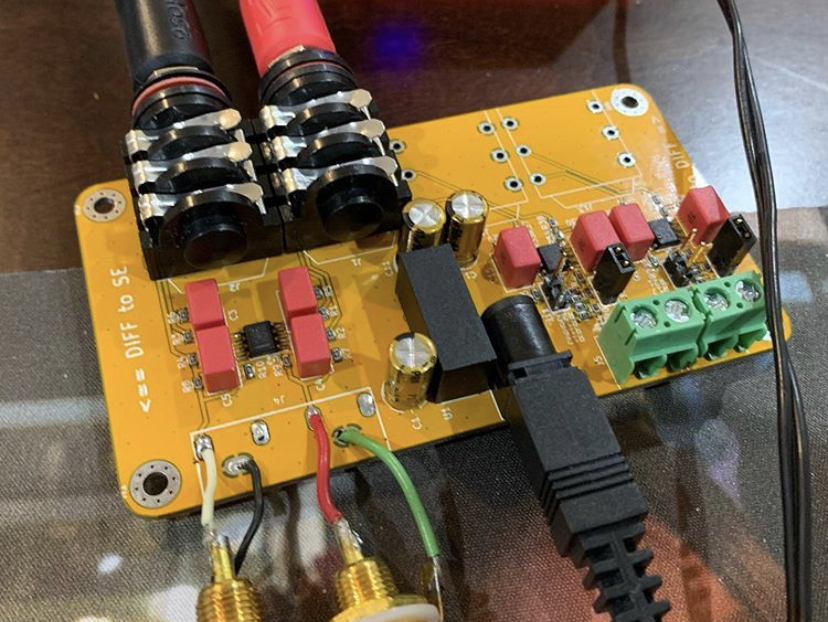
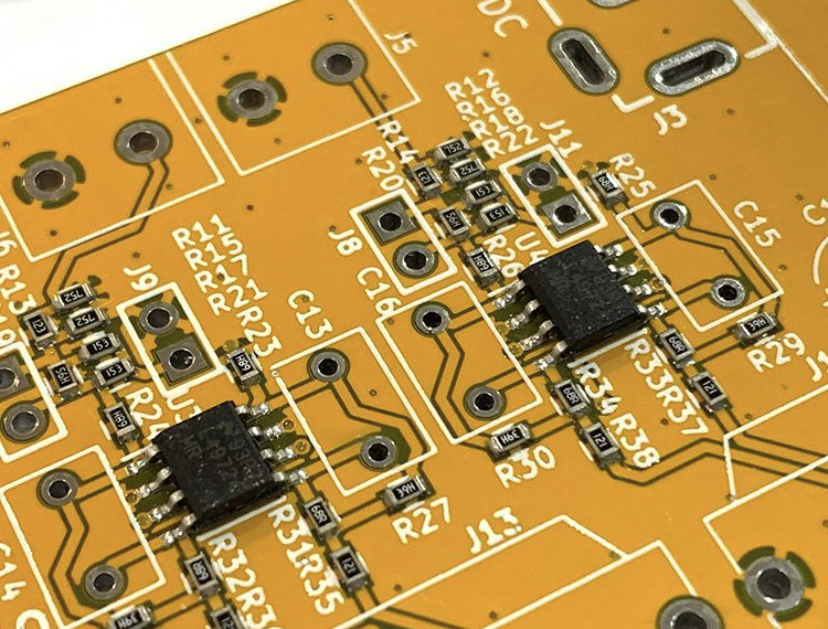
A more recent discovery that I made when doing higher power distortion tests is that the type of dummy resistor has a huge influence on the measured distortion level and harmonic distribution. You can forget about any wirewound dummy load. Forgot about metal oxide thick film, gold anodized metal shell wirewound are bad too. Any white cement filled one is bad. Even audio grade crossover resistors that claim to be low inductance. I broke one apart and they are still wirewound.
Don’t use these huge wirewounds unless you want to measure resistor generated high THD and extra high third harmonic:
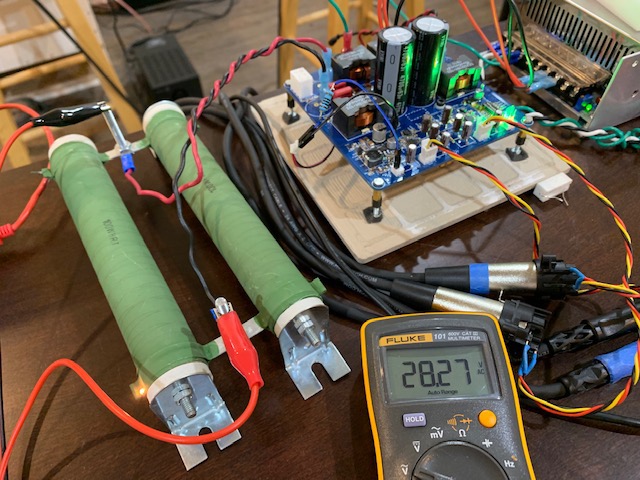
What works well are non wirewound bulk metal resistors that are laser trimmed to have a labyrinth path (not coiled or helical). An example is KOA Speer BPR series. They don’t come in high enough power though. I have used this as a source resistor in an amp and find that it is better than Panasonic ERX series.
Small axial metal thin film can work and if connected in series parallel can provide up to about 10w or so dissipation and very good performance.
Here was my metal thin film series parallel array of 16 2W resistors good for about 25w into 3.3ohms.
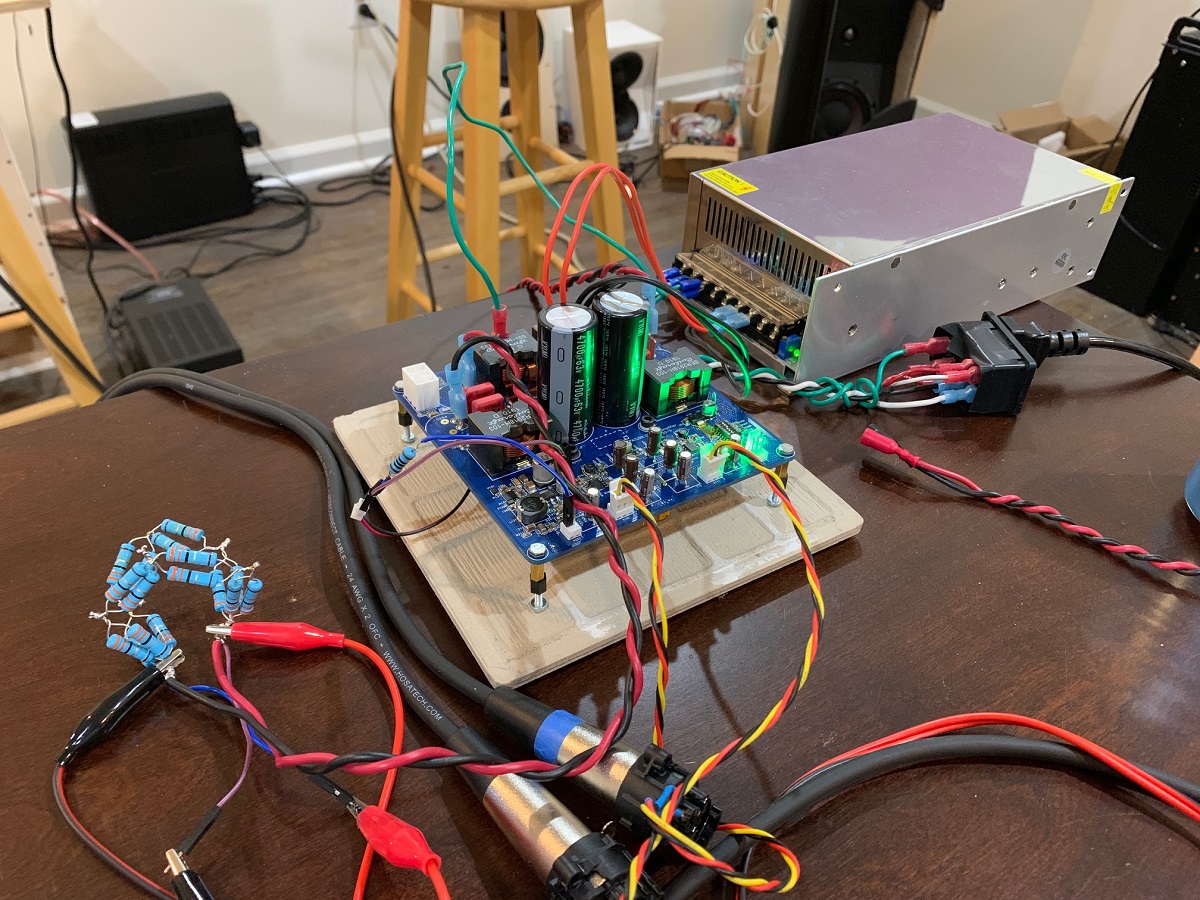
But what can one use if you want to test 200w? I have found that EBG ultra high power resistors (large area thin film) work very well. In fact, they are better than any other I have tested. They can be mounted to a CPU cooler for effective heat removal. They have very low thermal coefficients and are inherently inductance free (other than inductance of a flat conductor flowing along a plane.
EBG Resistors, manufacturer of high voltage, power thick film resistors
I have an older UXP-300-10. That’s 300w and 10ohms. It’s bolted to a Dell heat pipe CPU cooler. For tests under a minute or two, I can run it at 200w without a fan. For any sustained testing, a small fan is required.
Here is a photo of an EBG mounted you a CPU cooler in use while testing my TPA3255 amp to clipping at 32Vrms into 10ohms.
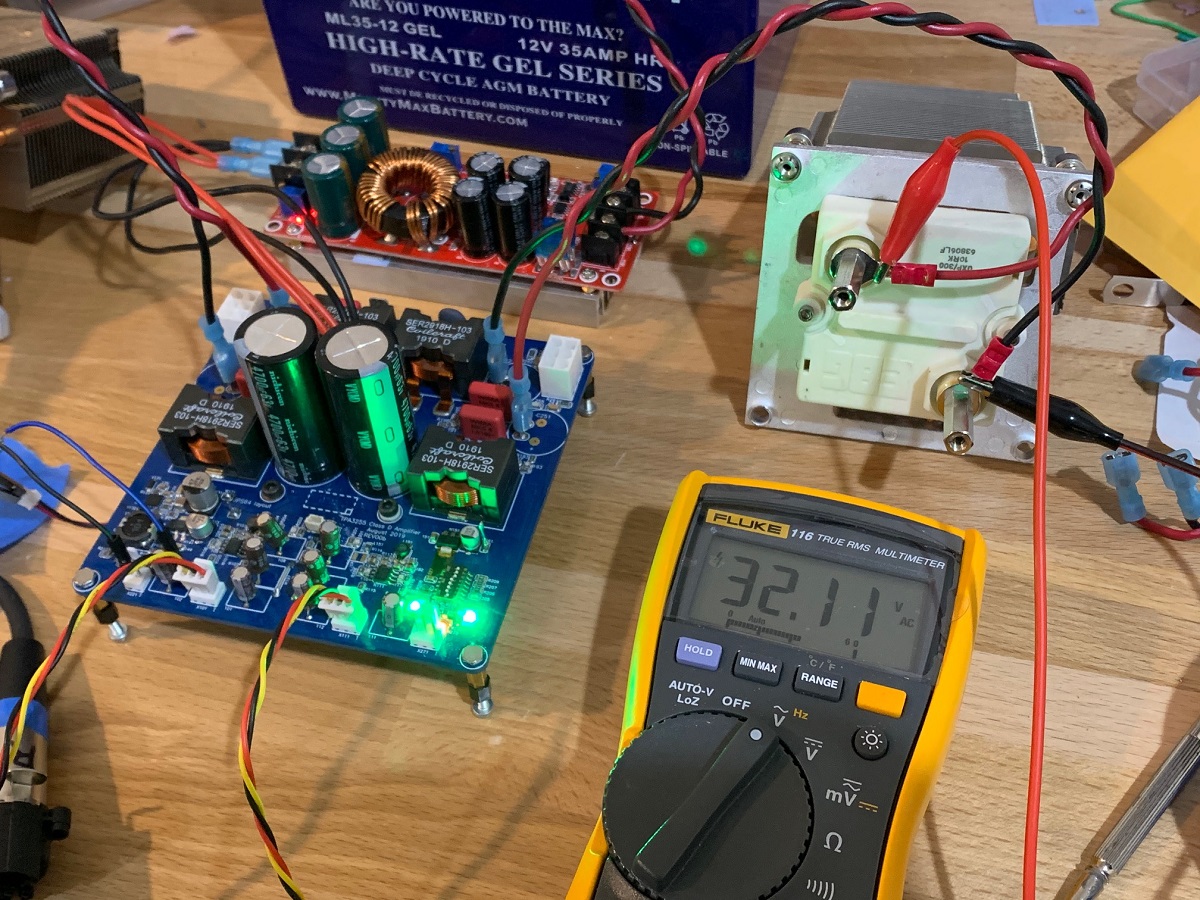
I have forgotten to visit this thread in a long time. Great to see activity and work on attenuators continues. Regarding attenuators, one other possible path is to use an active (but ultra low distortion) SE to balanced opamp such as LME49724 from TI. It has 0.00003% THD so good for many (if not most) DIY amps. Jhofland designed one for use with his Maudio sound interface but I can’t see what it won’t work with a Focsusrite or anything else needing balanced XLR input. Jhofland is installed two stages of attenuators at -14dB and -6dB (selectable on -6dB) for up to -20dB or 10x attenuation of a single ended input signal. The attenuators use high quality Susumu metal thin film SMT resistors. Here is a photo of the board. I am using it as a SE to Bal buffer so I actually bypassed the attenuators.
Data-sheet for LME49724:
http://www.ti.com/lit/ds/symlink/lme49724.pdf
A more recent discovery that I made when doing higher power distortion tests is that the type of dummy resistor has a huge influence on the measured distortion level and harmonic distribution. You can forget about any wirewound dummy load. Forgot about metal oxide thick film, gold anodized metal shell wirewound are bad too. Any white cement filled one is bad. Even audio grade crossover resistors that claim to be low inductance. I broke one apart and they are still wirewound.
Don’t use these huge wirewounds unless you want to measure resistor generated high THD and extra high third harmonic:
What works well are non wirewound bulk metal resistors that are laser trimmed to have a labyrinth path (not coiled or helical). An example is KOA Speer BPR series. They don’t come in high enough power though. I have used this as a source resistor in an amp and find that it is better than Panasonic ERX series.
Small axial metal thin film can work and if connected in series parallel can provide up to about 10w or so dissipation and very good performance.
Here was my metal thin film series parallel array of 16 2W resistors good for about 25w into 3.3ohms.
But what can one use if you want to test 200w? I have found that EBG ultra high power resistors (large area thin film) work very well. In fact, they are better than any other I have tested. They can be mounted to a CPU cooler for effective heat removal. They have very low thermal coefficients and are inherently inductance free (other than inductance of a flat conductor flowing along a plane.
EBG Resistors, manufacturer of high voltage, power thick film resistors
I have an older UXP-300-10. That’s 300w and 10ohms. It’s bolted to a Dell heat pipe CPU cooler. For tests under a minute or two, I can run it at 200w without a fan. For any sustained testing, a small fan is required.
Here is a photo of an EBG mounted you a CPU cooler in use while testing my TPA3255 amp to clipping at 32Vrms into 10ohms.
Attachments
Last edited:
Thanks for the load resistor information. I had problems finding much information on the availability and price on their products. Any recommended distributors of the EBG products?
Yes, I was going to say that’s where I got mine. A 600w 8ohm one is available for $40. I went for the $10 10ohm one instead.
Thanks for the Ebay link. I usually check there, but forgot this time. I bought 2 of the 10 ohm versions which I can parallel for a 5 ohm load. That's pretty close to the 4 ohm load I wanted.
I found my old Creative SB1240 Sound Blaster X-Fi HD USB Audio and put it in loopback mode. I even got ASIO4ALL to run for it (Windows 10).
My loopback test was at 997Hz and -7dBFS.
It's not great, but looked better than I expected based on the feedback I see about Creative these days.
Looks really bad if I up the level to 0dBFS, though.
Anybody else have one of these? How is yours?
mlloyd1
My loopback test was at 997Hz and -7dBFS.
It's not great, but looked better than I expected based on the feedback I see about Creative these days.
Looks really bad if I up the level to 0dBFS, though.
Anybody else have one of these? How is yours?
mlloyd1
Attachments
Last edited:
- Home
- Design & Build
- Software Tools
- How to - Distortion Measurements with REW
